Add Product
Table of Contents Show
Add Product
Create products and learn about several related features.
From the Manage Products page, or from the menu, go to Catalog > Products, click the Add Product button from the upper-right corner of the page.
Because products must belong to a category, the first step will be to select a Category from the list. This can always be changed later, but keep in mind that the URL for the product link may be generated from the category path.

After selecting a category, click the OK button to view the Add Product page.
The product information has several sections and configuration options. The Basic Product Information section is shown in the following example.
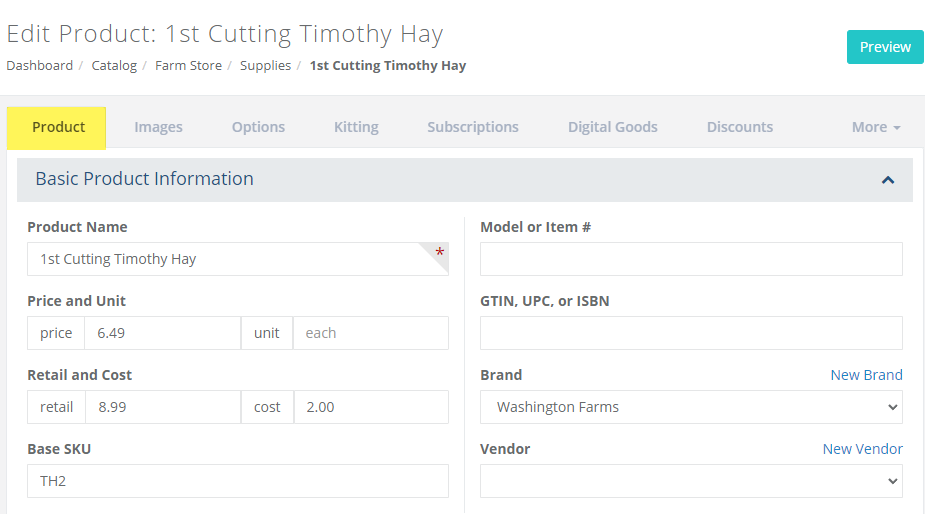
Enter a Product Name. This is required.
Note: The URL link will include the product name specified here, so keep this in mind if you need to change it in the future. A link that is indexed in a search engine will need a redirect if it is changed.The Price field contains the base price of the product. It can be 0 if you plan to offer priced options instead. This is before any discounts or specials are applied.
The Unit field is option and provides the customer information about the price. If nothing is entered here, the default value is "each".
The Retail field is informational only. This value can be displayed alongside the product price so the customer can view a calculated discount.
The Cost field is for admin use only. This is used with product reports so a merchant can view information pertaining to profits.
The Base SKU field can be used to display customers a specific item number in case the product name isn't specific enough. The Base SKU can be combined with product options to generate a detailed SKU. For example: Base SKU + Option SKU
The Model or Item # is for informational and search purposes only.
The GTIN, UPC, or ISBN is an open field where some other specific reference can be included with the product information.
The Brand selection is optional. By creating brands and assigning them to products, you can offer additional ways for customers to search your products.
Note: Brand is also referenced as Manufacturer within the application. For more information, see Brands.A Vendor selection is optional and typically used for drop-shipping products. When a Vendor is selected, the information is for internal purposes only. The Vendor will be notified by email when a product is sold. For more information, see Vendors.
Click the Save button when finished with the Basic Product Information section.
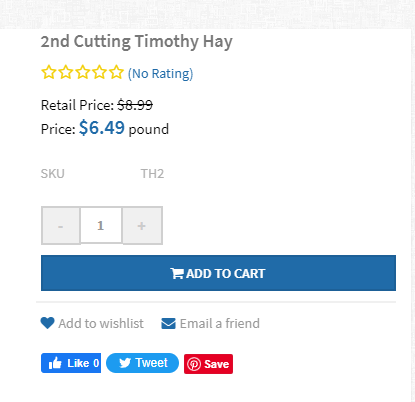
Once saved, use the Preview button from the upper-right corner or bottom action bar. An example is shown above. Continue reading to complete the entire product configuration.
Product Descriptions
From the Edit Product page, expand the section named Product Descriptions.

There are 3 types of product descriptions available. For each, there is a WYSIWYG editor to assist in making the text styled in HTML format.
Summary - The summary description is shown when the products are displayed in a group listing, such as on the category pages. There is no maximum number of characters that can be entered, but generally this description should be short and to the point.

Description
- The standard description field has no limit, however, Use the
built-in HTML editor to create your description content. The main
product description appears on the product page.
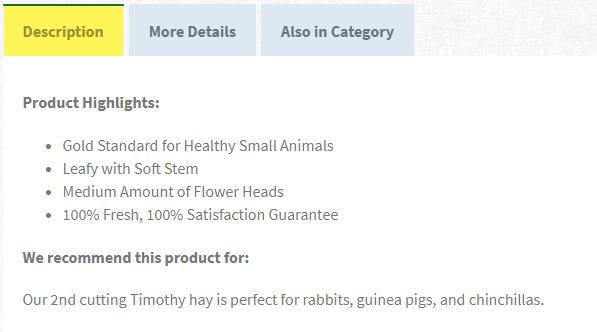
More
Details - This extra description field appears on the product
page from a separate tab or section. Typically, this is a more
detailed description for products that require it.

Click the Save button when finished with the Product Descriptions section.
Once saved, use the Preview button from the upper-right corner or bottom action bar. If you like, close the Product Descriptions section.
Continue reading to complete the entire product configuration.
Shipping and Tax
From the Edit Product page, expand the section named Shipping and Tax.
This section is shown in the example below. If the item is not shippable, then any applicable shipping configuration settings will be disabled.

Shipping - This setting determines how shipping will be calculated for the product.
Product is shippable - The product is shippable and can be shipped with other items.
Product is not shippable - The product is a digital good, or shipping calculations will not be applied at checkout.
Separately - .Special Condition - A product that needs to ship differently because it has special shipping requirements.
No - There are no special shipping conditions or prices for the product. (default setting)
Calculate Costs Separately - The product may be oversized or needs more accurate shipping costs. A separate shipment will not be created on the order, but calculations for the item will be calculated separately and then added to the total shipping cost for the shipment it is in. Typically used when dimensions of the product are necessary for accurate calculations.
Item Ships Separately - The product cannot be shipped with other items, so shipping calculations are based on the weight of this item alone, and added to the final shipping calculation. A separate shipment will be created for the order, and the item will be alone in the shipment with its own shipping methods.
Item Ships on Fixed Rate - The product has a fixed rate to ship. It will not be shown as a separate shipment, but rather the amount entered in the field will be calculated with the shipment cost. If the items ships free, leave the field empty.
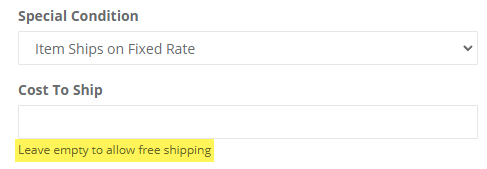
Weight - Enter the base product weight if it is shippable. This is a requirement if you are using a shipping service like UPS or USPS.
The "Billable Weight" link appears after shipping weight and dimensions are entered and saved. The calculation is available to assist merchants in determining whether the product dimensions will result in a higher billable weight than the actual weight entered. It is a common calculation that is used by USPS and UPS. Click the link to view the calculated billable weight. This information can only be calculated when dimensions are entered for the product.
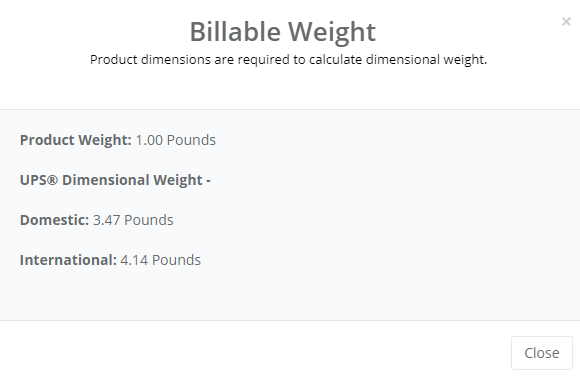
To avoid lower than cost shipping rates, it may be desirable to enter the calculated billing weight into the product weight field, or use the shipping setting to 'Calculate Separately' so product dimensions will always be used to determine the weight for shipping.Dimensions - The length, width, and height may be entered for each product, but these values are only used when the product's special shipping requirements are set to 'Calculate Costs Separately', 'Item Ships Separately', or when the product is the only item in the order. When products weights are combined to calculate shipping, then dimensions on each product cannot be sent to the shipping gateway.
Additional Handling Charges - Enter an amount that will be added as a handling fee or shipping surcharge. You can control the display and taxation of this fee by setting options from the edit shipping method page. The amount will be taxable if the handling charge has a tax code assigned. The amount can either be shown separately on the order, or combined with the shipping charges.
Warehouse - The shipping origin for this product. This is the address used for customer invoices and shipping calculations.
Ship Groups - Using shipping groups, you can further define which shipping methods will be available. For more information, see Ship Groups.
All - The product will be available to ship from all defined ship groups.
Selected Ship Groups - Only the selected ship group(s) and their shipping methods will be available to ship the product.Tax Code - The tax code is used to determine how the product will be taxed. If the product is not taxable, then remove the selection.
Gift Wrap - You can assign a Wrap Group to each product. These can provide several Gift Wrapping choices for your customers when checking out.
TIC - This is a special tax identification code used exclusively for the TaxCloud tax service. It should only be used if you wish to over-ride the default tax code value.
Inventory control
To use the inventory control feature, you must first enable it through the store configuration. For more information, see Inventory_Control to enable this feature and configure global inventory features for the store.
From the Edit Product page, expand the section named Inventory Control. This section is shown in the example below.

Each product may use its own inventory tracking setting. The Inventory setting has three options:
Disabled - the product will not be using any inventory control method.
Track Product - the base product's inventory levels will be tracked with each purchase.
Track Variants - the product has a variety of options, and inventory will be tracked for each product option purchased.When the Allow product to be purchased if out-of-stock option is checked, you are allowing customers to purchase inventory that is no longer available.
The Turn on notification service when inventory is out-of-stock is a feature that enables customers to sign-up for a notification when the product is back in stock.
The In Stock and Notification level setting indicates the amount of inventory available for purchase and when stock levels need to be replenished.
In Stock - Enter the In Stock value for a product. This is the actual amount of inventory available.
Low Stock - Enter value for Low Stock. This value sets the threshold for the amount of stock remaining when an email notification is sent and also when it will be shown on the Manage Low Inventory page.
Availability Date - Select a date that inventory is expected to be available again. The date is only shown to the customer when the Allow product to be purchased if out-of-stock option is unchecked (off) and the In Stock level has been depleted to 0.
Click the Save button when finished with the Inventory Control section.
Continue reading to complete the entire product configuration.
Additional Settings
From the Edit Product page, expand the section named Additional Settings.
This section is shown in the example below.

Theme - Select from the list of themes available, or use the store's default theme. For more information, see Themes.
Page Template - Select from the list of template pages available, or use the store's default template page. See Page Templates.
Display page - Select from the list of inner templates available, or use the store's default inner template. See Inner Templates.
Visibility - A setting which determines whether the product will be shown to Public (all users), Hidden (available through direct link only), or Private (unable to view or purchase).
NOTE: Products changed to Private will be removed from a user's shopping basket before checkout begins.Group Restrictions - You may create new groups and assign them to specific products. This setting is disabled by default, which means the product can be viewed by any user. If you choose to enable a group restriction, then select one or more groups from the list provided. The product can only be viewed by users who belong to one of these groups. A new group can be created from the People > User > Groups page.
NOTE: If you are using membership only products as part of a non-member Kit, then the member product will still appear as part of the Kit. However, the user will not be able to directly view the member only product unless they have membership access.Include product in Featured Listing - While checked, this product, and any other products, will be randomly displayed where the Featured Products widget has been added.
Require user to click a link to view price - If checked, the product price will not be immediately viewable within the store, unless the user clicks on a link to Show Price, or adds the item to their shopping cart.
Create a gift certificate with purchase - When checked, the product turns into a gift certificate that, when purchased, will activate a system generated serial number for the amount of the product purchase. The gift certificate serial number can be used on any item within the store it was created from.
Allow customers to review this product - If checked, users can submit product reviews. Additional settings are available from product review configurations.
Product is prohibited by Paypal Express Checkout - If checked, this product (and any other items within the same order) will be unavailable to the PayPal Express Checkout payment feature. Typically due to the type of product being sold.
Disable product from all purchases - If checked, the product will still be displayed in your store, but there would be no ability to purchase the item.
Exclude From Feeds - If checked, the product data will not be included in any of the feeds available within AbleCommerce.
Allow user to enter their own price - When checked, the customer can enter an amount between the minimum and maximum price accepted. Enter the minimum and/or maximum amounts into the fields provided.
Require a minimum or maximum purchase quantity - Enter the minimum and /or quantity of this item that must be purchased before checkout can be completed.
Additional Search Keywords - When you have a product that is commonly misspelled, you can enter the misspelled names into this field. The internal search feature will use these keywords to help the customer find the product.
Search Engine Optimization
From the Edit Product page, expand the section named Search Engine Optimization.
This section is shown in the example below.

Meta Description - Enter a summary description in text only. This is what search engines will use as a description for the page.
Page Title - Enter a custom page title if desired. If this value is left blank, then the product title will be used.
Meta Keywords - Meta keywords are meta tags that you can use to give search engines more information about a page's content. They're found in a webpage's HTML source code, and are not visible to visitors.
HTML Head - You may use this field to include custom scripts within the HTML head field.
Product URL - If desired, you can enter your own URL, or link to this product. These are relative URL's to the store installation path.
Changing a Product URL
Click the Change link to enter a different URL.
The Product URL field will now be editable. Enter a new URL.

An option to create a URL redirect from the old link to the new link is checked by default. If the original link has never been indexed by a search engine, it is ok to uncheck this option. Otherwise, leave the option checked so that any old links will be routed to the new one.
Click the Save button in the bottom footer. The application will check to make sure the value is unique before saving, and a warning message will appear if it's not.
Google Shopping Feed
From the Edit Product page, expand the section named Google Shopping Feed.
This section is shown in the example below.

Include product in Feeds - If this option is checked, then the product will be included in any generated feeds.
Publish Feed using Variants - If checked, the product will be published to Google Feed using the variants defined by color, size, material, or pattern. In order to use this feature, you must be using the "Apparel & Accessories" Google category. See Options and Variants for detailed information.
Condition - Select the condition of the item for sale. Options are New, Used, and Refurbished. See Condition attribute.
Color - If you are listing an apparel item through Google Feed, it is required to enter the color. See Color attribute.
Gender - Select the gender of the item if it is applicable. Options are Unisex, Male, or Female.
Size - If you are listing clothing or shoes through Google Feed, it must enter the size. See Size attribute.
Age Group - If applicable, you can select a specific age group for Adults, Kids, Toddler, Infant, or Newborn. See Age attribute.
Google Category - If using the Google feed, enter the category for the product. See Product Taxonomy for a list of valid categories.
Exclude Destination - Select to exclude the product from Google Shopping or Commerce Search. See Excluded Destination attribute.
Product Groups - If using Google Adwords, you can enter a name to group together products. See Product Groups for more information.
Custom Labels - If using Google Adwords and CPC, you can enter one or more labels for the product. See Custom Labels attribute.
Adwords Redirect - You can enter a different URL for advertising and tracking purposes. See Adwords Redirect attribute.
See Google Feeds if you would like more information and requirements for submitting product feeds.
When finished, click the Save or Save and Close button in the bottom footer.